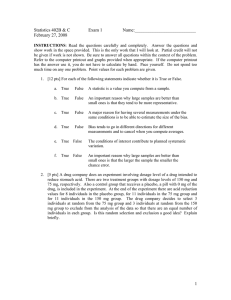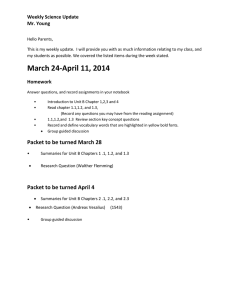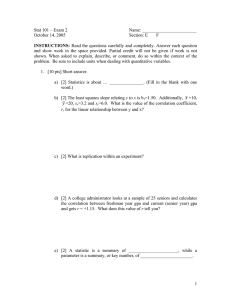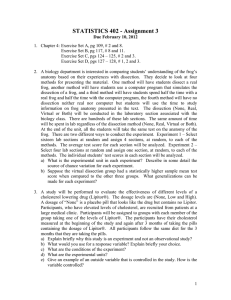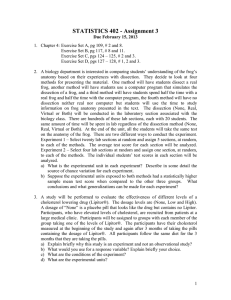Statistics 402B & C February 27, 2008
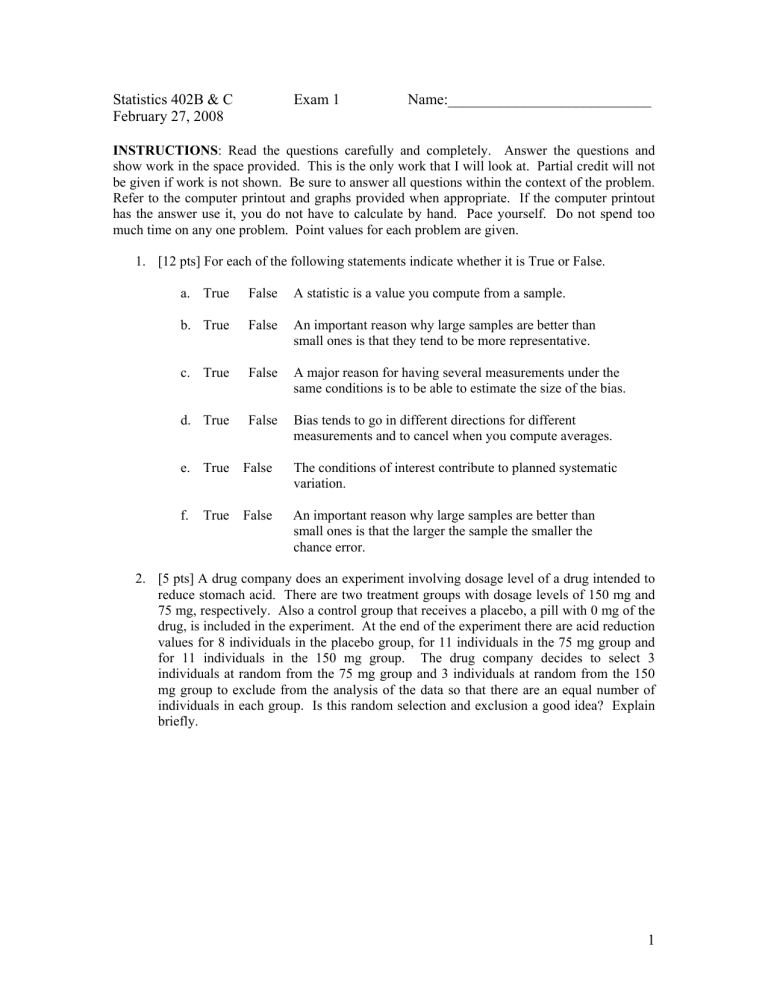
Statistics 402B & C
February 27, 2008
Exam 1 Name:___________________________
INSTRUCTIONS : Read the questions carefully and completely. Answer the questions and show work in the space provided. This is the only work that I will look at. Partial credit will not be given if work is not shown. Be sure to answer all questions within the context of the problem.
Refer to the computer printout and graphs provided when appropriate. If the computer printout has the answer use it, you do not have to calculate by hand. Pace yourself. Do not spend too much time on any one problem. Point values for each problem are given.
1.
[12 pts] For each of the following statements indicate whether it is True or False. a.
True False A statistic is a value you compute from a sample. b.
True False An important reason why large samples are better than small ones is that they tend to be more representative. c.
True False A major reason for having several measurements under the same conditions is to be able to estimate the size of the bias. d.
True False Bias tends to go in different directions for different measurements and to cancel when you compute averages. e.
True False The conditions of interest contribute to planned systematic variation. f.
True False An important reason why large samples are better than small ones is that the larger the sample the smaller the chance error.
2.
[5 pts] A drug company does an experiment involving dosage level of a drug intended to reduce stomach acid. There are two treatment groups with dosage levels of 150 mg and
75 mg, respectively. Also a control group that receives a placebo, a pill with 0 mg of the drug, is included in the experiment. At the end of the experiment there are acid reduction values for 8 individuals in the placebo group, for 11 individuals in the 75 mg group and for 11 individuals in the 150 mg group. The drug company decides to select 3 individuals at random from the 75 mg group and 3 individuals at random from the 150 mg group to exclude from the analysis of the data so that there are an equal number of individuals in each group. Is this random selection and exclusion a good idea? Explain briefly.
1
3.
[10 pts] A biology department is interested in comparing students’ understanding of the frog’s anatomy based on their experiences with dissection. They decide to look at three methods for presenting the material. One method will have students dissect a real frog, another method will have students use a computer program that simulates the dissection of a frog, and a third method will have students spend half the time with a real frog and half the time with the computer program. The dissection (real, virtual or both) will be conducted in the laboratory section associated with the biology class. There are hundreds of these lab sections. The same amount of time will be spent on dissection regardless of the dissection method (real, virtual or both). At the end of the unit, all the students’ will take the same test on the anatomy of the frog. There are two different ways to conduct the experiment. Experiment 1 – Select three lab sections at random and assign one section, at random, to each of the methods. The individual students’ test scores in each section will be analyzed. Experiment 2 – Select 15 lab sections at random and assign 5 sections, at random, to each of the methods. The average test score for each section will be analyzed. a.
[4] What is the chance variation in the experiment? Describe in some detail the source of this variation.
Experiment 1:
Experiment 2: b.
[6] Suppose the virtual dissection group had a statistically higher mean test score compared to the other two groups. What generalization can be made?
Experiment 1:
Experiment 2:
2
4.
[8 pts] A laboratory has four different scales that could be used to obtain the mass of objects. In order to see how accurate and precise each of the scales is a technician uses each scale to repeatedly determine the mass of an object known to be 20 milligrams.
Below are histograms of the results of the repeated measurements. Describe the accuracy
(bias) and precision (variability) of each scale.
40
40
30
30
20
20
10
10
0
0
0
0
10
10
20
20
30
W eight (mg)
30
40
40
Scale 3
40
30
20
10
0
0 10 20
W eight (mg)
30 40
Scale 2
40
30
20
10
0
0 10 20
W eight (mg)
30 40
Scale 4
40
30
20
10
0
0 10 20
Weight (mg)
30 40 a.
[2] Scale 1 b.
c.
d.
[2] Scale 2
[2] Scale 3
[2] Scale 4
3
5.
[11 pts] A psychologist does an experiment involving memory. One theory regarding memory states that verbal material is remembered as a function of the degree to which it was processed when it was initially presented. To test this theory an experiment is run with literate adults. The first factor is learning group. Subjects in the Counting group read through a list of words and count the number of letters in each word. Subjects in the
Rhyming group read a list of words and think of words that rhyme with each word on the list. Subjects in the Adjective group read a list of words and think of adjectives that modify the words, one adjective for each word. Subjects in the Imagery group read a list of words and form vivid images for each word. None of these four groups is told that they will later have to recall the words. Subjects in a fifth group, the Intentional group, are asked to memorize a list of words for later recall. After subjects read through a list of words three times, they are asked to write down all the words they can remember. The number of words correctly recalled is noted for each subject. In addition to the learning groups there is a second factor of interest involving the age of the subject. Subjects are classified as younger (age less than 55) or older (age greater than or equal to 55). i.
[6] What are the response, conditions and experimental units?
Response
Conditions
Experimental units ii.
[3] Give an outside variable that should be controlled in this experiment. Explain briefly how it can be controlled. iii.
[2] Explain briefly how replication will be included in this experiment.
4
6.
[29 pts] The experiment described in 5 is performed using 50 younger adults and 50 older adults. There are 10 adults randomly assigned to each of the 10 treatment combinations.
Refer to the JMP or SPSS output for Memory Experiment. i.
[2] With Alpha = 0.05 and Beta = 0.10, what size difference learning group means will this experiment be able to detect? ii.
[4] Test the hypothesis that the treatment effects are zero
H
0
:
11
21
31
41
51
12
22
32
42
52
0
against the alternative that at least one is not zero. Be sure to report the appropriate test statistic, P-value, decision, reason for the decision and a conclusion within the context of the problem. iii.
[4] Test the hypothesis that the learning group effects are zero
H
0
:
1
2
3
4
5
0
against the alternative that at least one is not zero. Be sure to report the appropriate test statistic, P-value, decision, reason for the decision and a conclusion within the context of the problem. iv.
[4] Estimate the size of the five learning group effects.
5
v.
[3] From the computer output what is the value of Kramer-Tukey’s HSD? Using the HSD which differences in sample mean number of words recalled for the five learning groups are statistically significant. vi.
[4] Test the hypothesis that the interaction effects are zero
H
0
:
11
21
31
41
51
12
22
32
42
52
0
against the alternative that at least one is not zero. Be sure to report the appropriate test statistic, P-value, decision, reason for the decision and a conclusion within the context of the problem. vii.
[2] What does a statistically significant interaction indicate about the relationship between the number of words remembered and learning group? viii.
[3] Comment on the plot of Residuals versus Learning group and the sample standard deviations for the Learning groups. What do these tell you about the conditions necessary for the analysis of variance? ix.
[3] Comment on the distribution of Residuals. What does this tell you about the conditions necessary for the analysis of variance?
6
